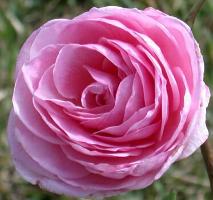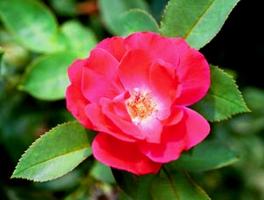Some people consider roses the queen of the landscape. Their blooms are among the most popular of all garden flowers. In a traditional rose garden, modern hybrid teas produce long-stemmed cut flowers with perfect form. But such roses require considerable care in order to maintain optimum plant health and bloom production. We have some suggestions for the best roses for Austin that are easy to care for.

Belinda’s Dream Earth-Kind® Rose
Old garden roses, or antique roses, have enjoyed a growing popularity in recent years. These roses predate the appearance of the first hybrid tea rose in 1867. We are also seeing an increased interest in shrub roses, both old and modern, along with an emphasis by breeders on disease resistance. Many modern roses now possess superior disease resistance to some of the best old garden roses. As a result roses have spread from the “rose garden” out into the landscape.
Shrub types that look great even when not in bloom make great hedges or specimen plants. Miniature roses are great for containers or small planting beds. Climbers grace fences, arbors or form pillars of bloom on upright posts.
Texas A&M AgriLife Extension makes it easier to decide which roses to plant by giving select rose cultivars an Earth-Kind® designation. The designation is based on extensive research results awarded only to those roses demonstrating superior pest tolerance and outstanding landscape performance. You can see a list of the recommended cultivars on the Earth-Kind Roses website.
Why is it recommended in Central Texas to prune roses in February?

Lady of Shallot David Austin Rose
Central Texas has two seasons: summer and NOT summer. Spring is virtually non-existent, so plants go from dormant to wide-awake in what seems like a matter of minutes. Many roses, especially if planted in a warm, protected spot, may not even drop all of their leaves in winter. So how do we decide when to prune? It partly depends on the type of rose.
Wait to prune climbing roses until after they’ve flowered. Prune all other roses around Valentine’s Day as long as they are still dormant. If they are already blooming, just wait until they have finished to prune. Prune repeat bloomers like Knockout and Mutabilis at any time of year to keep them in shape.
No matter when you prune, it’s very important to choose buds that will grow outward, rather than toward the interior of the plant, in order to improve air circulation in the center. This helps to prevent black spot and other fungal and bacterial problems and reducing the need to spray. In winter, cooler temperatures expose the red leaf pigments confusing many to think it’s a nutrient deficiency. Frost and wind damage coupled with temperature fluctuations can cause a leaf-drop in the winter, another instance where disease is often the mistaken cause. “Normal” color patterns in leaves will be very symmetrical and usually first appear as a red mottling near the margins. Diseased leaves will appear splotchy and the pattern will normally not be symmetrical. And one more note on pruning: there are a couple of exceptions to our February pruning advice.
Rose Rosette Virus Alert
Rose Rosette Disease (RRD) is a devastating disease of roses. It makes the rose unsightly because of abnormal growth of the rose plant tissue and can eventually kill the entire plant. Symptoms vary by the type of rose and include witches’ brooms, excessive thorniness, enlarged canes, malformed leaves and flowers. Knock Out® roses seem especially vulnerable, but no rose is safe from the virus. The eriophyid mite is the vector. More information can be found at Rose Rosette.org
How to Diagnose Rose Rosette
In the early stages of the disease it can mask as new growth or herbicide damage. The difference is that the new reddened foliage never turns green, and the distorted growth never disappears. Nutrient deficiency may also resemble RRD injury, but will typically affect the whole plant. Therefore, it is important to check for combinations of RRD symptoms over time.
What to Do
If you suspect that your roses are infected, the best solution is to remove and completely destroy the plant. This means roots, leaves and other parts of infected plants should be completely cleared from an area. Do not use a leaf blower, as it may blow mites onto healthy plants; instead, debris should be removed by hand, placed in a sealed bag and disposed of off-site. It is also recommended that you wait 1 to 2 months after removing infected plants before transplanting healthy ones. You can help track the disease by reporting to Rose Rosette.org. This data is only used by researchers.
Can You Prevent Rose Rosette?
Today there is no known cure but research on the disease continues in earnest. The best thing you can do for prevention is to maintain health and vigor of all your rose plants by watering during periods of drought, testing soils and applying fertilizer as needed, as well as controlling other diseases and insect pests.
Additional Rose Resources
Old Roses by Dr. William Welch
How to Prune Rose Plants YouTube video with Dr. Brent Pemberton, AgriLife Research Ornamental Horticulturalist
Rose Bush Care YouTube video with Skip Richter
What’s Growing On: Rose Trial Results YouTube video with Bill Holcombe
What’s Growing On: Rose Pruning YouTube video with Dr. Larry Stein
Pruning Methods for Roses from Aggie Horticulture
Solving the Mystery of Pruning Roses by Dr. Douglas Welsh
Rose Pruning Handout from El Paso County Master Gardeners
Rose Pruning by Illinois Extension
Earth-Kind® Roses – Master Gardener Training
Rose Propagation from Cuttings by Dr. William Welch
Texas A&M University Rose Breeding and Genetics Program Check out the page Rose Breeding for Beginners


